EURO 2016 final preview
The final of EURO 2016 is upon us. The hosts, France, are met by Cristiano Ronaldo’s Portugal after they overcame Germany and Wales respectively in the final four.
Assuming that both teams don’t change shape for the occasion, we’re likely to see France’s 4-2-3-1 formation up against what is a rough Portuguese 4-4-2. Alternatively, there’s a chance we could see a diamond midfield from Portugal – something which they used in the semi-final. Without Carvalho in the side, Danilo was introduced to the starting lineup as a 6 whilst Silva moved into a 10 position. Regardless of the actual formations, both shapes are rather dynamic in attack and we can undoubtedly expect to see fluctuations over the course of the match. The likes of Ronaldo and Nani have rather free roles off of the ball whilst players such as Payet and Griezmann are active from the hosts.
Portuguese Defensive Approach
In defence, Portugal generally fall back into three lines of players and defend in a 4-4-2. They only occasionally move out to press and otherwise defend in a mid-block with a clear passivity in the two strikers. Ronaldo and Nani occupy the first line and are commonly disengaged from the defensive efforts – the former in particular as they likely preserve their energy for attacks. Behind the two strikers, the four midfielders are quite clearly oriented towards covering their man. Portugal frequently cross the line between a man-oriented zonal defence and straight-up man-marking as each midfielder follows their man closely, often irrespective of alternative reference points. Even if a midfielder is moving away from the ball and is reducing his capacity to receive a pass, his marker will follow him closely and with a surprising intensity.
However, with a change of shape necessary for the semi-final against Wales, we also a shift in their defensive strategy. As opposed to following their man closely, we saw Portugal sit in a compact 4-1-2-1-2 diamond shape and they stuck to their positions more out of possession. Some focus on the opponent remained, especially with Silva situationally man-marking Joe Allen and some man-coverage of Bale and other forwards in deeper positions, but it was less rigid than their previous outings. Due to this different approach, Portugal were more stable in the midfield with fewer gaps opening up against the off-the-ball movement of the opposition. During Welsh build-up, the defence would force the ball into the wing-backs where the midfield diamond could rather comfortably shift across and press the limited space on the touchline whilst in deeper possession, the shape diamond flattened to an extent as Portugal defended the opposition’s wing focus.

Portugal had a more flexible defence against Wales, despite maintain some orientation towards the man.
In both defensive schemes, the overall strategy remained fairly consistent. The forwards remained fairly passive during build-up whilst the midfield looked to block any Welsh passing options into the midfield thus forcing them into wider positions. Although small adaptions were made, such as the focus on Allen and other situational cases of man-marking, the general intentions of the defence remained the same. Ronaldo was again rather disengaged during Wales’ build-up and instead preferred to drift off into his left half-space. From this position, the Real Madrid forward was in a strong area to make direct runs into space in the case of a Welsh turnover.
In some cases, the strikers’ wider positioning is used as a means of restricting the playmaking opportunities for the centre-backs. By occupying the half-spaces, Ronaldo and Nani can effectively act as blockers for any potential forward drives by the defenders. Although they don’t have to expend much energy in doing so (as they’re literally just occupying the space with little high-intensity actions) it can be an effective and efficient means of disrupting the opponent’s build-up.
It is possible that Fernando Santos recognised the issues they had faced with the man-marking approach and adapted accordingly however it’s highly unlikely. International sides rarely change their approach mid-way through a tournament and much less commonly when in the semi-finals, especially when it hasn’t been exposed yet despite the open gaps. Instead, it seems like the change of shape was the major factor in the shift. With defensive midfielder Carvalho unavailable, Santos structured his side in a narrow diamond to face Wales and with that the defensive strategy seemed to change too. This could’ve been because they felt it was more suited to the chosen defensive formation or possibly it could’ve been used specifically for Wales who, especially without Ramsey, had only Joe Allen as a creative force in the midfield.
Because of this, it’s difficult to predict how Portugal will approach the final. I’m leaning towards a reverting back to their original shape and possibly man-marking as Carvalho becomes available once again. However, their performance against Wales was one of their best in the tournament and, especially with the added defensive stability, I wouldn’t be surprised if Santos stuck with the same approach for the final.
Man-Marking against French Fluidity
If Portugal revert to their man-oriented defensive approach, they could face some serious issues against what has been a potent French attack. As a result of this rigid defensive scheme, gaps can open quite regularly within the midfield of Portugal’s block. The central midfielders often get dragged apart and the disconnect results in large spaces which can be exploited by the opponents through other players dropping in. Despite this quite clear issue, many teams have failed to capitalise on this so far – Austria were unable to form any dangerous attacks due to a vertically-disconnected shape, Croatia failed to integrate other attackers with Modric and Rakitic followed closely whilst Poland, despite looking to expose them with direct play, fell short with poor decision making higher up.
With France as the opponents however the outcome could be drastically different. Their attacking shape is more fluid and dynamic than anything Portugal have faced before whilst Antoine Griezmann has been arguably the player of the tournament by dropping into midfield gaps. The powerful and direct runs through the right by Sissoko could be a challenge for whoever is tasked with marking him whilst Dimitri Payet poses a very different and greater threat on the left side of the attack. The fluid and dynamic nature of France’s attacking structure means that many players can move out of position and occupy any available spaces within the opposition’s defence. This is something they did particularly well in their demolition of Iceland with Payet and Griezmann in particular finding defensive holes frequently.
How Portugal deal with the flexibility of France’s attack will be crucial in the development of the final on Sunday. Against a man-oriented approach as rigid as Portugal’s, France have a great opportunity to open spaces in the midfield and disorient their opponents through their dynamic off-of-the-ball movements. The flexible positioning of Griezmann and Payet which we saw against Iceland could be a major key in their attacking game as both could find themselves open whilst Portugal’s midfielders are man-marking their teammates.
Deschamps could use the oppositional man-oriented defence to his advantage by creating isolation situations with their best dribblers. Payet is the obvious candidate for this down the left side and if France are looking for a means of creating a chance, the ball may well fall at his feet. By drifting into wider positions away from the rest of the attack, the WHU star has the potential to isolate his man and contest him with his strong dribbling abilities. Other options are Griezmann and Pogba, who displayed great technical ability in his 1v1 against Kimmich on Thursday night before setting up the second.
As for a specific strategy to accomplish this, France could look towards their deeper midfielders in order to drag the opponents out of position. Both Pogba and Matuidi could potentially occupy wider positions than normal and serve to drag the central midfielders out of position. By dropping diagonally into their respective half-spaces, they could invite the likes of William Carvalho out of position and open the gaps for the likes of Griezmann and Payet higher up.
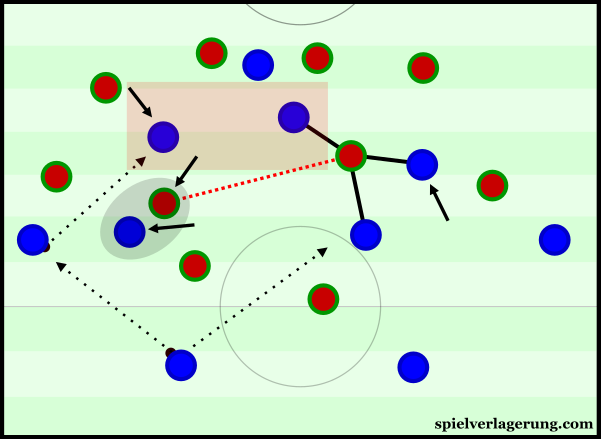
France’s deeper midfielders could open space through dragging the Portuguese midfielders out of position.
With Portugal rather passive in the opposition build-up, it’s possible that Pogba especially may be able to control the game from the deep position where he has done in a few matches this tournament. If Santos’ side want to restrict the Juventus midfielder’s influence, then they may have to approach him with a stricter man-marking approach. If this is the case, then Pogba needs to utilise the opponents’ focus on him to open space for teammates, as he could do by dropping or moving wider than usually.
Will Structural Problems Blunt Portugal’s Attack?
The most restricting factor in Portugal’s offensive game is their positioning as a team. Their structure is rarely conducive to playing through the lines and with the forwards given the responsibility of positional freedom, they fail to coordinate themselves well. The individualistic nature of attackers such as Ronaldo and Nani mean that their movements are rarely tailored towards supporting teammates or improving the level of connections. This aligns itself well with Portugal’s attacking strategy (or perhaps lack of one) as Santos’ team often relies on the individual quality of the forwards to cause a threat upon the opposition’s defence, something which has been criticised by many over numerous lacklustre attacking displays. They do seem to have some focus on crossing (with the most headed shots per game at 4.5) and particularly Ronaldo looks to stay high in the box during these moments, but otherwise they’re limited in what is a rather one-dimensional attack.
This attacking structure is central to the one-dimensionality of their attacking play as it significantly restricts their ability to coordinate attacks as a team and integrate other players in the opposition’s half. The lack of synergy between the forwards means that the responsibility handed by Santos is rather misplaced – in order to be fully effective, players such as Nani often require a define system to play in. Without this, the positioning and movements of the Portuguese players aren’t cohesive enough to create structures which allow effective ball movement in the opposition’s half and although this is somewhat representative of what Santos wants them to do, it causes more harm than benefit. Their ability to penetrate the opposition’s midfield line has been very restricted this tournament and instead they’re limited to more horizontal ball circulation, often moving the ball side-to-side before a hopeful direct ball towards Ronaldo in the front line.
During spells of possession in the opposition’s half, the attacking shape is quite stretched and not very ball-oriented. The forwards are likely to stay in the front line and will only drop at times, but neither Nani nor Ronaldo possess the team-tactical intelligence to do so in a manner which would create valuable connections within the structure. The midfield line is often quite flat and stretching the width of the pitch with little variation across the chain. This often creates two distinct lines of players (with the addition of the full-backs) between which there are little connecting players. Without anyone within the 10 space on a consistent basis, the gap means that it becomes difficult to bridge the attacks with short passes moving upfield.
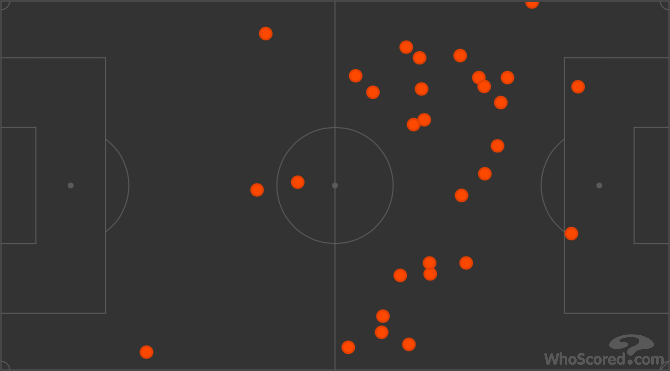
Ronaldo’s passing positions against Wales. Despite having a free role in possession, he struggled to positively impact their build-up. (whoscored.com)
How Might France Approach a Low Block?
Whilst lacking the potency of the top attacks up top, Portugal have got to the final more through frustrating their opposition through their play without the ball. Despite having the deficiencies stated above, their defence has stopped many attacks from creating chances with Pepe being particularly impressive in leading the back-line. With their key centre-back likely returning for the final, it’s expected that Portugal will look out to frustrate France again.
It wouldn’t be surprising to see Santos opt for a deeper defence after seeing the damage caused by the pace of Griezmann and Payet in attack. If this ends up being the reality, it will be interesting to see how the hosts approach their attacking strategy with an adaption required after their last two games. It could be possible that France are tasked in finding a more direct approach to goal, as players such as Griezmann won’t profit from the same amount of space they got against the high defensive lines of Iceland and Germany. They do have such an option in Olivier Giroud whilst they can rely on a player such as Payet to make good deliveries from wide areas, however it’s certainly not their preferred attacking style.
Transitions
Ever since undergoing the tutelage of Diego Simeone, Antoine Griezmann as developed into one of the best forwards in the world. From the star winger at Sociedad, he has become much more well-rounded and is an extremely dynamic attacker perfect for counter-attacking. It is the Atletico Madrid striker who leads France’s attacks on the break as he uses his excellent pace, movement and ball-carrying ability to cause great threat against many defences. In his heroic semi-final performance against Germany, the sharp forward frequently found pockets of space in transition as he was the focal point of many attacks. Receiving the ball in space, he could quickly turn and drive the ball forward as France gained space quickly on their fast breaks. The movement of Griezmann before and during transition will be something which Portugal must take into great consideration if they don’t want to be opened up on turnovers.
Deschamps side are one of the stronger counter-attacking teams in the competition and use their pace well on the break. Creating just under 1 shot per game off of the counter-attack, France look to expose their opponents with Griezmann and Payet being two impactful figures. Combine the pace and technical abilities of these players with the direct running of the midfielders and France have a side well-suited to playing on the break. Their ability on the break could also be an important tool against Portugal too, who have shown a frailty in defensive transition in previous matches.
Poland had some joy when playing on the counter against Santos’ team by using direct balls towards the forward upon regaining possession. Playing in their 4-4-2 shape, Portugal’s midfield were often caught rather flat upon losing the ball which resulted in a weak coverage over the space between the midfield and defence lines. In order to expose this, Poland would play long balls towards Lewandowski and Milik who could win the knock-downs or second balls and start the attacking transition in an advanced position. Had the Portuguese midfield been better staggered vertically with players at different ‘heights’ on the pitch, this could’ve potentially be avoided. However with them positioned on the same horizontal line across the width of the pitch, their capacity to vertically cover the space was quite poor.
If they are able to keep both Griezmann and Giroud in high positions, they could be a similar target of these long balls. This is a common role for Giroud and Griezmann is now far from the typical winger and has shown a capability to be a presence in the air over the past season. If this pairing are able to be adequately supported by the athletic runs of players such as Matuidi or Sissoko, then Deschamps’ side could form some threatening attacks on the fast break.
If Portugal play as expected and play in an even more reserved manner than they have appeared in previously however, such chances may be difficult to come across for Deschamps’ side. With William sitting deep during spells of possession, Portugal may well be looking to play a more conservative game in attack and look to restrict the space available to France’s forwards following turnovers.
On the other hand, Portugal are another team who could threaten in transition. Considering their player profiles its easy to see that they’re well-suited to playing in transition with the two forwards being the focal point of their counter-attacks. Their approach is somewhat more vertical than their upcoming opposition as they intend to get the ball into Ronaldo as soon as possible after regaining possession. When the ball is in higher zones (whether it be through the long ball or a higher turnover), they try to establish dangerous attack through combinations amongst the forwards. Although it’s very much stating the obvious, Ronaldo will be the key figure if Portugal aim to create any chances on the break and France must be oriented around stopping the ball from getting to the Real attacker.
Conclusion
Although two of the most tactically impressive sides of the tournament (Italy and Germany) aren’t going to feature, Sunday’s final will still be a highly-interesting match. The most important battle could be seen in the centre of the pitch as France will try to break free and exploit Portugal’s man-oriented defence. Portugal will have to overcome their structural issues in possession and are likely to do this through transitions or pure individual talent, either way – Cristiano Ronaldo will be central to their chances as the forward looks to win a trophy for his national side.
Here at Spielverlagerung, we will be following the match in the form of a live analysis hosted on our site – keep an eye out closer to the match for more information!
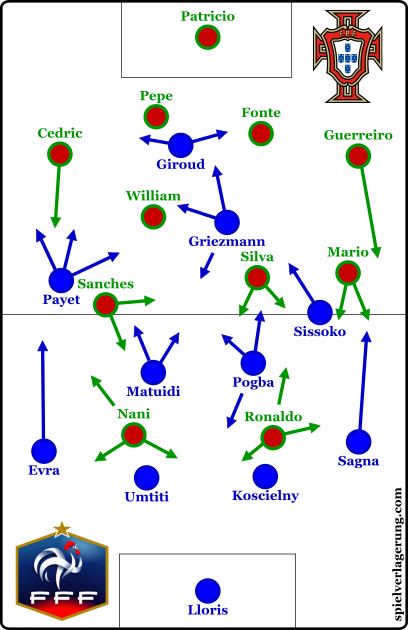
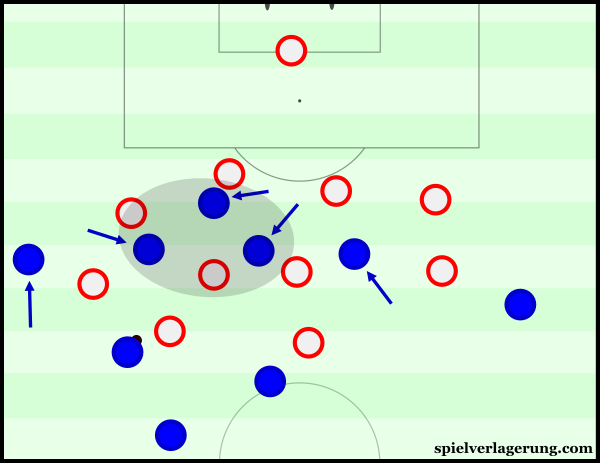
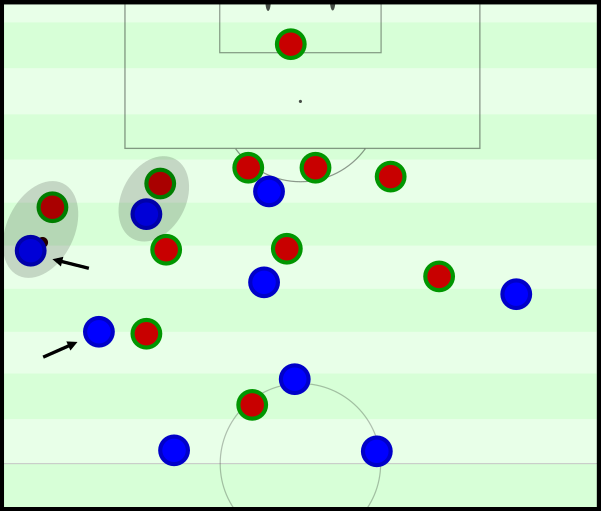
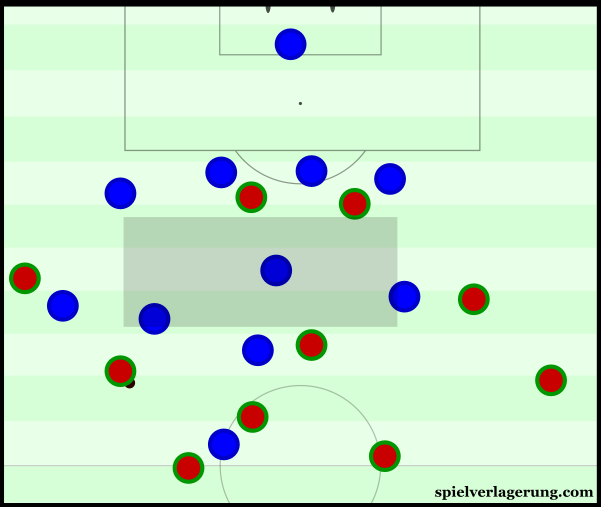
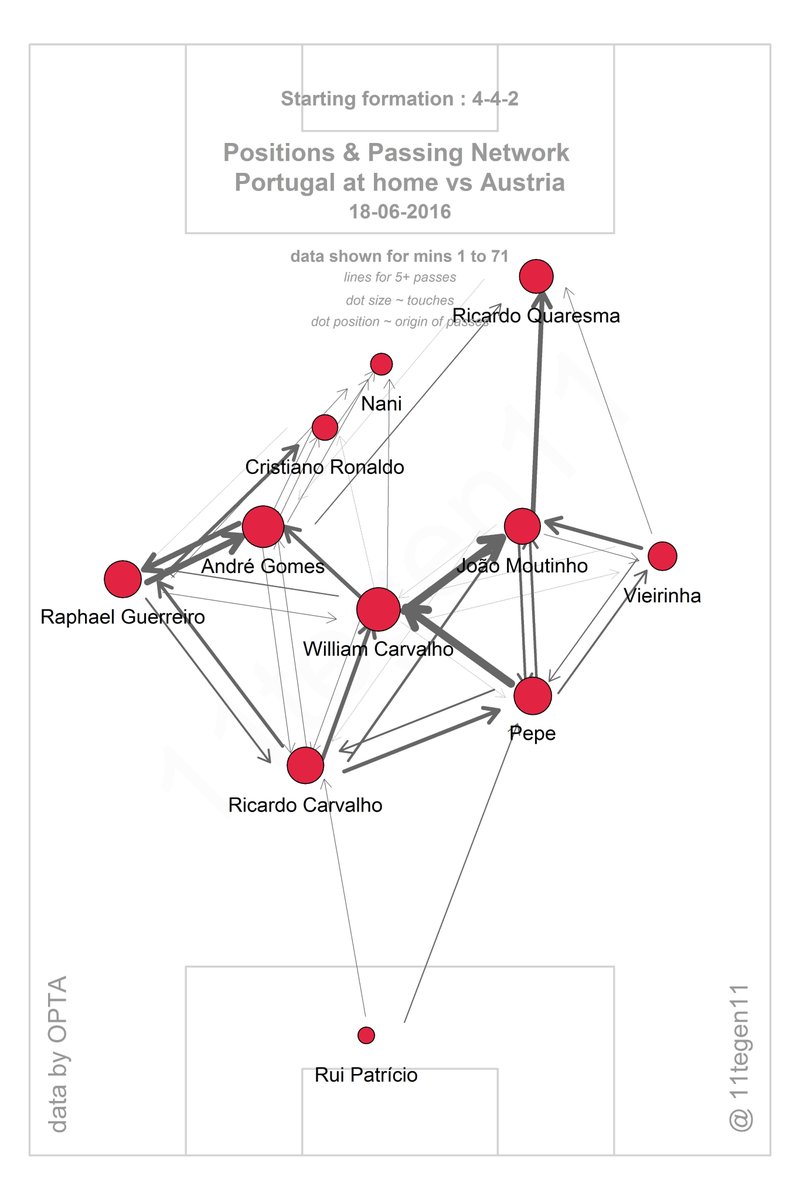
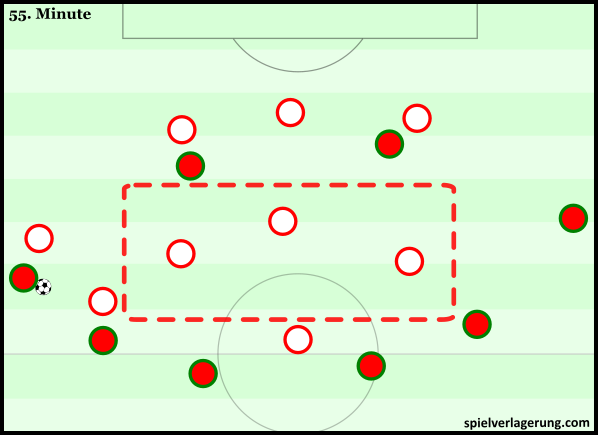
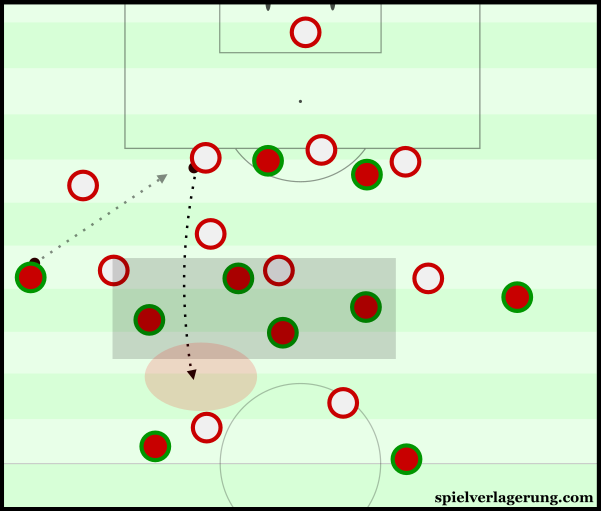
Keine Kommentare vorhanden Alle anzeigen